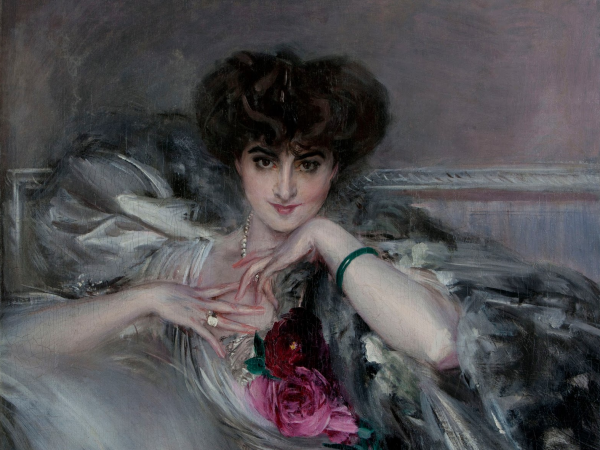 |
| Princess Catherine Radziwill, ca. 1910 |
By the Princess Radziwill [1] — The Russian court was always famous in the old days, when it existed, for the number of pretty women at its balls and festivities, as well as for the quantity of magnificent jewels which they wore. At present, owing to the events which have taken place during the last four years [2], a great many of these historical parures have been sold or otherwise disposed of, and it might be interesting to recall the memories of the splendid jewels and lovely women who made the festivity at the Winter Palace so brilliant.
It is useless here to speak about the crown diamonds. These have been described so often. It was the Empress [3] alone who had the right to use them or to wear them, and then only upon certain occasions, when she would request, through the head of her household, the crown treasurer to bring to her the ornaments she wished to put on. The latter sent them to the sovereign, under an escort composed of one officer and four soldiers, when a formal receipt would be given to him in exchange. When the Empress had taken them off they were brought back with the same formalities to the treasury, when the receipt would be returned. The Dowager Empress [4] hated these formalities, and had obtained from Alexander III the authorization to keep, together with her own jewels, those which belonged to the crown, but after her widowhood she was compelled to return them, much to her sorrow.
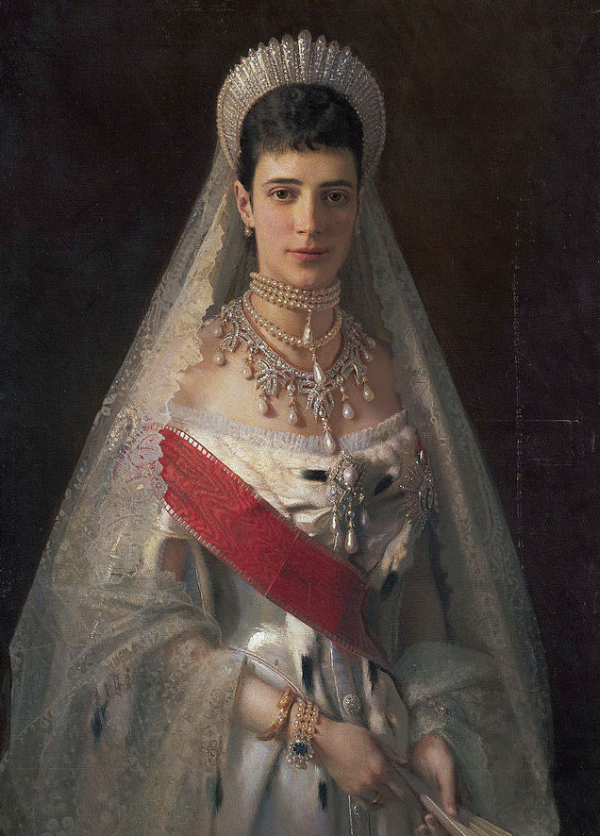 |
| Marie Feodorovna, wearing her diamond kokoshnik and her diamond and pearl wave necklace, in a portrait by Ivan Kramskoi, ca. 1881 (Wikimedia Commons) |
Apart from these official parures, Marie Feodorovna possessed also some magnificent ornaments of her own, among others a wonderful pearl necklace, which had been bequeathed to her husband by his grandmother, the wife of Nicholas I, with the condition that he should present it to his consort upon his marriage. She had also the most magnificent turquoises and emeralds in existence, and she was constantly adding to the contents of her jewel boxes.
Her sister-in-law, the Grand Duchess Vladimir [5], also possessed quite remarkable pearls and diamonds, among others a tiara and necklace of large brilliants with the most extraordinary pear-shaped pearls in the world. They were supposed to have been given by Catherine II [6] as a wedding present to the consort of her son, the Grand Duke Paul, and to have been bequeathed by the latter to one of her daughters, who in her turn left them to the Grand Duke Vladimir, who in his childhood was a favorite of hers.
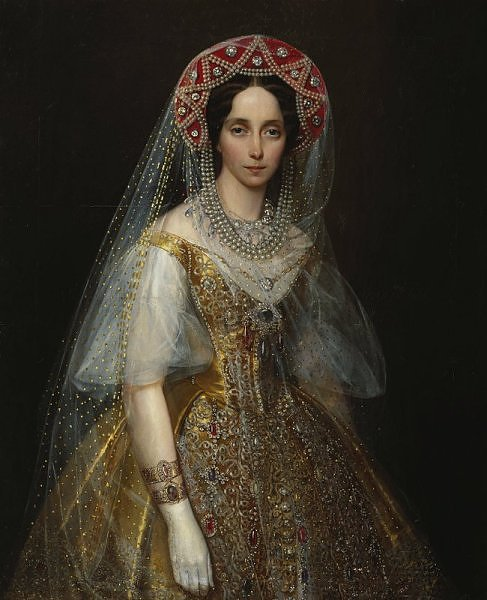 |
| Maria Alexandrovna in a bejeweled portrait by Ivan Makarov (Wikimedia Commons) |
The personal jewels of Empress Maria Alexandrovna [7], the grandmother of Nicholas II, were equally divided among her sons and her daughter, the Duchess of Edinburgh [8]. The latter had already received, when she married, any amount of ornaments, among others the rubies which had once belonged to the Empress Eugenie [9], who after the revolution of September 1870 sold them to Czar Alexander II. He gave an enormous price for them. It is not known what the Duchess of Edinburgh has done with all the wonderful jewels she possesses, but the other Russian grand duchesses have parted with most of those which they had and sent them to Paris and London to be sold. It is likely that several of these historic parures will find their way to the United States sooner or later.
Private ladies in Russia also had beautiful jewels. The diamonds and rubies of the late Madame Durnovo [10] could have been worn by any queen, while those of the Princess Youssoupova [11] were priceless. The latter inherited from her father several large boxes full of the most splendid unset stones that he had been collecting all his life and always kept under lock and key. She has nineteen rows of pearls, each one as large as a small cherry, the longest of which falls down to the bottom of her skirt, and her tiara of yellow diamonds is also quite a unique thing, the like of which could not be matched. Davydoff and Madame Leon Narischkine [12] have also wonderful ornaments, while the pearl and diamond tiara which belonged to the late Princess Anna Scherbatoff had once belonged to the Empress Josephine [13] and rivaled that of the Grand Duchess Vladimir to such an extent that many people could not tell which was the more beautiful.
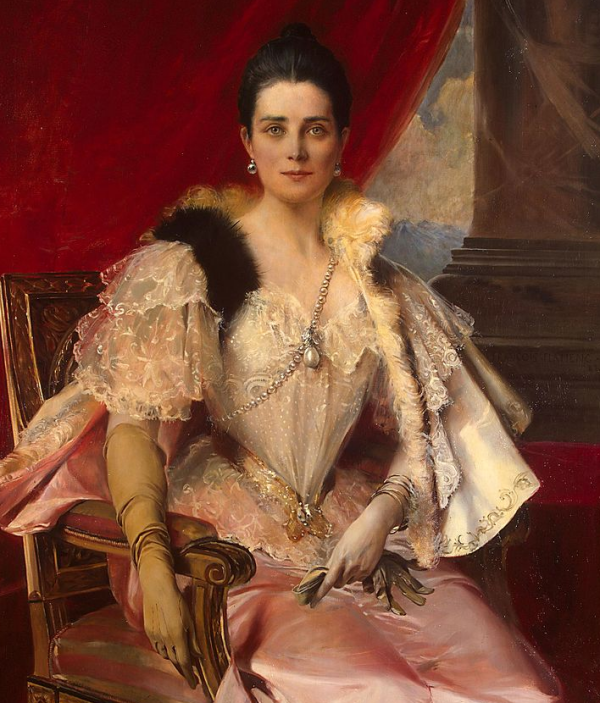 |
| Zinaida Yusupova, wearing the La Pelegrina Pearl, in a portrait by Francois Flameng, ca. 1894 (Wikimedia Commons) |
Yes, it was a pretty sight to see all these stones and gems flashing around the necks and on the heads of all these lovely women. It is not likely that a ball will ever be given again in the Winter Palace, and very probably none of us will ever behold the spectacle it presented to the onlooker in those past but never-to-be-forgotten times. In other countries, too, one could see beautiful jewels, but I doubt whether there were every such a number as in the St. Petersburg of those days.
It seems, though, that in Italy the Roman princesses possess even more splendid ornaments than the great ladies of the Russia of former times. The rubies of the Princess Doria and the diamonds of the late Duchess of Torlonia are still the envy of the jewelers of the world, who would give anything to be able to dispose of them. In Spain, also, as well as in Austria, the aristocracy possess gems of inestimable value, and in Hungary the pearl necklaces which one sees remind one of those which are described in the Arabian Nights.
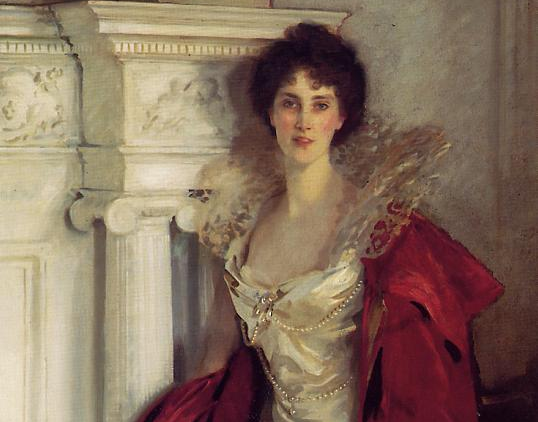 |
| Winifred Cavendish-Bentinck, Duchess of Portland in a portrait by John Singer Sargent, ca. 1902 (Wikimedia Commons) |
But still, after the jewels which I have seen exhibited at court festivities in St. Petersburg, I think that the most lovely ones I have ever looked upon have been in London, where peeresses on state occasions show quite an extraordinary display of pearls, diamonds, and other precious stones. The sapphires of the Duchess of Abercorn [14], for instance, are the finest known, and could have been compared with advantage to those which until lately were in possession of the Russian crown. The pearls of the American Duchess of Marlborough [15] are matchless, not only in size, but also in purity and coloring, while the diamonds belonging to the Westminster family and to the Duchess of Portland [16] are quite admirable.
I do not mention the English crown jewels, because their history is too well known. It is sufficient to say that the big South African diamond [17] is the largest in the world, leaving far behind it the (until then) famous Orloff, the Koh-i-Noor, and the Regent, which is still the property of the French state. When the Queen wears it all other stones in the room seem insignificant. It is related that she is herself careful not to put it on together with any other of her diamond ornaments, for fear they should sink into nothingness behind it [18].
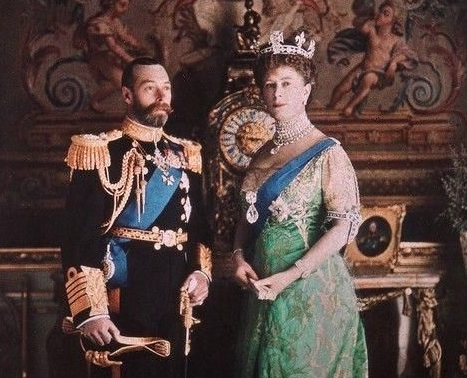 |
| A colorized portrait of King George and Queen Mary; note the Cullinan I and II Diamonds worn as a brooch on her bodice, as well as the Koh-i-Noor set at the front of her crown (Wikimedia Commons) |
One wishes sometimes one could know the history of all these wonderful gems one sees adorn the person of fair women. If they could speak, what tales they would relate to us, what dramas of love, hate, joy, and sorry they would unfold to us. Queens and princesses, noble ladies and fair sinners, all have worn them, all have liked them and cared for them, and the vicissitudes of human life have been so often embodied in these delicate jewels that even to those who do not care for them they appeal by the mystery which hovers over them, by all that they reveal to us of past hopes, past misfortunes, and lost happiness, as well as by the “vanitas vanitatum” they recall.
NOTES
1. Princess Catherine Radziwill (1858-1941), born Countess Ekaterina Adamovna Rzewuska, was a Russian aristocrat who married a Polish prince, Wilhelm Radziwill. A prominent (but frequently scandalous) figure at the Russian and German imperial courts at the turn of the twentieth century, Catherine knew many of the important figures of the day, and she wrote about many of them in numerous books, including Behind the Veil at the Russian Court (1913-14). That book is now in the public domain, and it can be read for free online here.
2. The events referenced here include World War I, which began in 1914, and the Russian Revolution of 1917. This article ran in various newspapers in March 1918, a year after Tsar Nicholas II’s abdication. At this point, Nicholas, Alexandra, and their children were still alive. But only a few weeks after this article was published, the family was transferred to Yekaterinburg, where they were executed in July 1918.
3. Alexandra Feodorovna of Russia (1872-1918), born Princess Alix of Hesse and by Rhine, was the last Empress of Russia. A granddaughter of Queen Victoria of the United Kingdom, Alix married Tsar Nicholas II in November 1894. They had five children together, and the entire family was executed by the Bolsheviks after the 1917 revolution and Nicholas’s subsequent abdication.
4. Marie Feodorovna of Russia (1847-1928), born Princess Dagmar of Denmark, was Russia’s empress consort as the wife of Tsar Alexander III. She survived the 1917 revolution and later died in exile in her native Denmark.
5. Maria Pavlovna of Russia (1854-1920), born Duchess Marie of Mecklenburg-Schwerin, became a Russian grand duchess when she married Grand Duke Vladimir Alexandrovich, son of Tsar Alexander II, in 1874. She was an important social leader in St. Petersburg at the end of the Romanov dynasty, and she had an enormous jewel collection, including this sapphire kokoshnik, this diamond fringe, and her famous diamond and pearl circle tiara.
6. Catherine II of Russia (1729-1796), born Princess Sophie of Anhalt-Zerbst and better known as “Catherine the Great,” reigned as Empress of Russia from 1762 until her death in 1796.
7. Maria Alexandrovna of Russia (1824-1880), born Princess Marie of Hesse and by Rhine, was Russia’s empress consort through her marriage to Tsar Alexander II. Her children included Tsar Alexander III, the Duchess of Saxe-Coburg and Gotha, and Grand Duke Vladimir.
8. Maria Alexandrovna, Duchess of Saxe-Coburg and Gotha (1853-1920), born Grand Duchess Maria Alexandrovna of Russia, was the only daughter of Tsar Alexander II. She married Prince Alfred, Duke of Edinburgh (the second son of Queen Victoria and Prince Albert) in 1874. In 1893, Alfred and Maria became Duke and Duchess of Saxe-Coburg and Gotha after the death of Alfred’s childless uncle, Ernst. Her children included Queen Marie of Romania and Victoria Melita, who was first Grand Duchess of Hesse and by Rhine and then a Russian grand duchess.
9. Empress Eugenie of France (1826-1920), born Eugénie de Montijo, was France’s empress consort from 1853-1871 through her marriage to Napoleon III of France. After the monarchy was abolished in the wake of the Franco-Prussian War, Eugenie and her family went into exile in England.
10. Madame Durnovo was a Russian society hostess who held a salon in St. Petersburg.
11. Zinaida Yusupova (1861-1939) was the incredibly wealthy daughter of important figures at the Russian imperial court. Known for her great beauty, Zinaida was an important Russian society hostess in the years before the revolution, serving as a lady-in-waiting to both Marie Feodorovna and Alexandra Feodorovna. She also amassed an astonishing personal collection of jewelry. Her son, Felix, was one of the assassins of Gregory Rasputin.
12. Vera Sergeevna Narischkine (1883-1963) was a close friend of the Dowager Empress Marie Feodorovona.
13. Lots of jewels are said to have connections with Empress Josephine; some are genuine, many others are not. Here’s one of my earlier posts on the topic.
14. Rosalind Hamilton, Duchess of Abercorn (1869-1958), born Lady Rosalind Bingham, was the wife of the 3rd Duke of Abercorn. One of her daughters, Cynthia, married the 7th Earl Spencer and became the grandmother of the late Diana, Princess of Wales.
15. Consuelo Spencer-Churchill, Duchess of Marlborough (1877-1964), born Consuelo Vanderbilt and later Consuelo Balsan, was the first wife of the 9th Duke of Marlborough. As this article was being published, Consuelo was in the process of donating some of her famous jewels to raise money for the women and children whose husbands and fathers were World War I casualties. You can read my previous article on the fundraising effort here.
16. Winifred Cavendish-Bentinck, Duchess of Portland (1863-1954), born Winifred Dallas-Yorke, was the wife of the 6th Duke of Portland. She was one of the canopy bearers for Queen Alexandra during the 1902 coronation.
17. This is, of course, the Cullinan Diamond. More on that incredible gem over here. You can also read about some of the other incredible diamonds mentioned here in our post on enormous royal diamonds!
18. Catherine Radziwill clearly didn’t spend much time with Queen Mary. She loaded on additional diamonds with the Cullinans all the time!
Leave a Reply